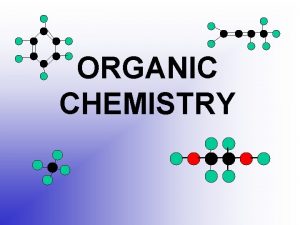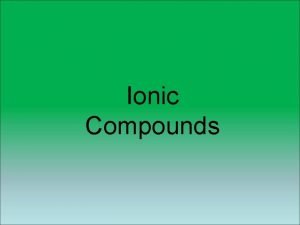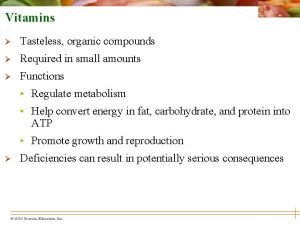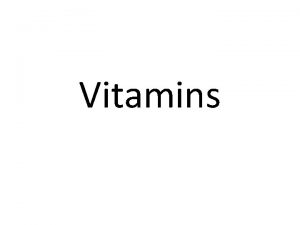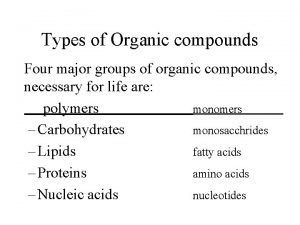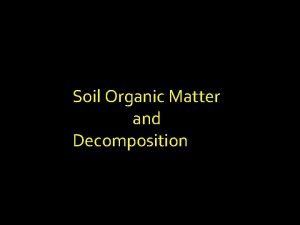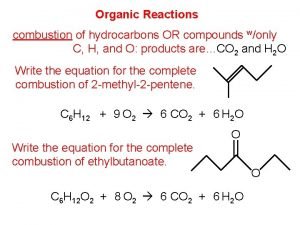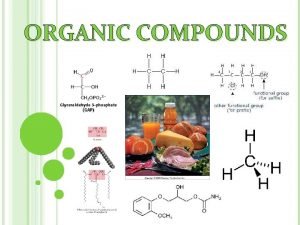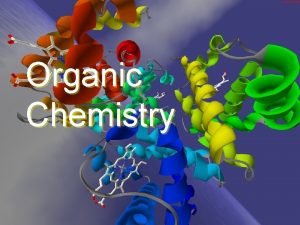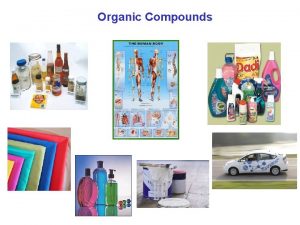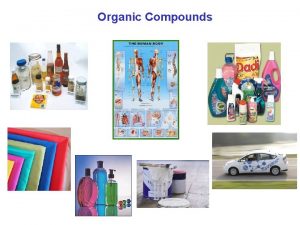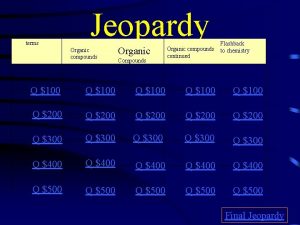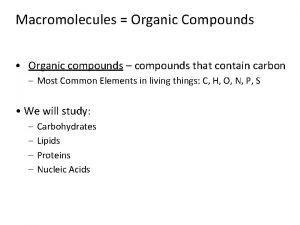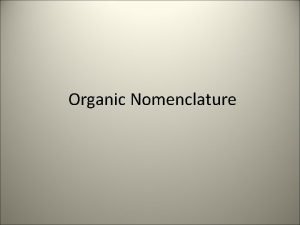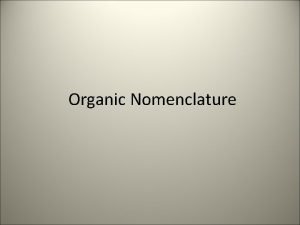Characteristics of Organic Compounds 1 Generally nonpolar generally










- Slides: 10

Characteristics of Organic Compounds 1. Generally non-polar (generally insoluble in water) 2. Soluble in non-polar solvents (likes dissolve in likes ) 3. Non-electrolytes 4. Reactions generally occur slowly 5. Have low melting points due to weak intermolecular forces 6. Reactions have high activation energy, and therefore lower reactions

Hydrocarbons Definition - compounds composed of only hydrogen and carbon Homologous series - group of organic compounds with similar properties and related structures (differ from each other by CH 2)

Alkanes Hydrocarbons with the formula Cn. H 2 n+2 (Table Q) All alkanes end in “ANE”. Example: methane, propane All alkanes have all SINGLE bonds and are saturated hydrocarbons.

Alkyl Group (side chains) Alkyl structures have one less hydrogen than the corresponding alkane. Side Chain Length In Carbons Name Side chain name Alkyl Formula Cn. H(2 n+2 -1) 1 methyl CH 3 2 ethyl C 2 H 5 3 propyl C 3 H 7 4 butyl C 4 H 9 5 pentyl C 5 H 11 6 hexyl C 6 H 13

Isomers Organic compounds that have the same molecular formula, but different structural formula. The more carbons in the structure, the more isomer variations that are possible. Butane 2 -methylpropane

Alkenes Hydrocarbons with the formula Cn. H 2 n (Table Q) All alkenes end in “ENE”. Example: ethene, propene All alkenes have at least one DOUBLE bond (C=C) and are considered unsaturated hydrocarbons.

Alkynes Hydrocarbons with the formula Cn. H 2 n-2 (Table Q) All alkenes end in “YNE”. Example: ethyne, propyne All alkynes have at least one TRIPLE bond (CΞC) and are also considered unsaturated hydrocarbons.

Functional Groups (Table R) Not all organic compounds are hydrocarbons!! Different functional groups cause compounds to have different physical and chemical properties!!

Functional Groups: Physical Properties Boiling Point/Melting Point The greater the # of carbons in carbon chain, the higher the boiling point/melting point! If compounds have the same # of carbons: Highest BP/MP *Alcohols Ethers *Acids Amines Aldehydes Ketones Lowest BP/MP Hydrocarbons

Organic Reactions that involve organic compounds. There are seven (7) reactions we will discuss: Substitution (alkane) Addition (alkene/alkyn) Combustion (carbon comp. + O H O + CO ) Fermentation Esterfication (organic acid + alcohol) Saponification (opp. of esterfication – soap) Polymerization (many small 1 big) 2 2 2
 Carbon compound
Carbon compound Are ionic compounds metals or nonmetals
Are ionic compounds metals or nonmetals Water soluble vitamin absorption
Water soluble vitamin absorption Vitamin classification chart
Vitamin classification chart The four major groups of organic compounds are
The four major groups of organic compounds are Decomposition of organic matter equation
Decomposition of organic matter equation Charring test of organic and inorganic compounds
Charring test of organic and inorganic compounds Combustion reaction of organic compounds
Combustion reaction of organic compounds Organic compound made by living things
Organic compound made by living things All organic compounds must contain the element
All organic compounds must contain the element Organic compounds must contain
Organic compounds must contain
